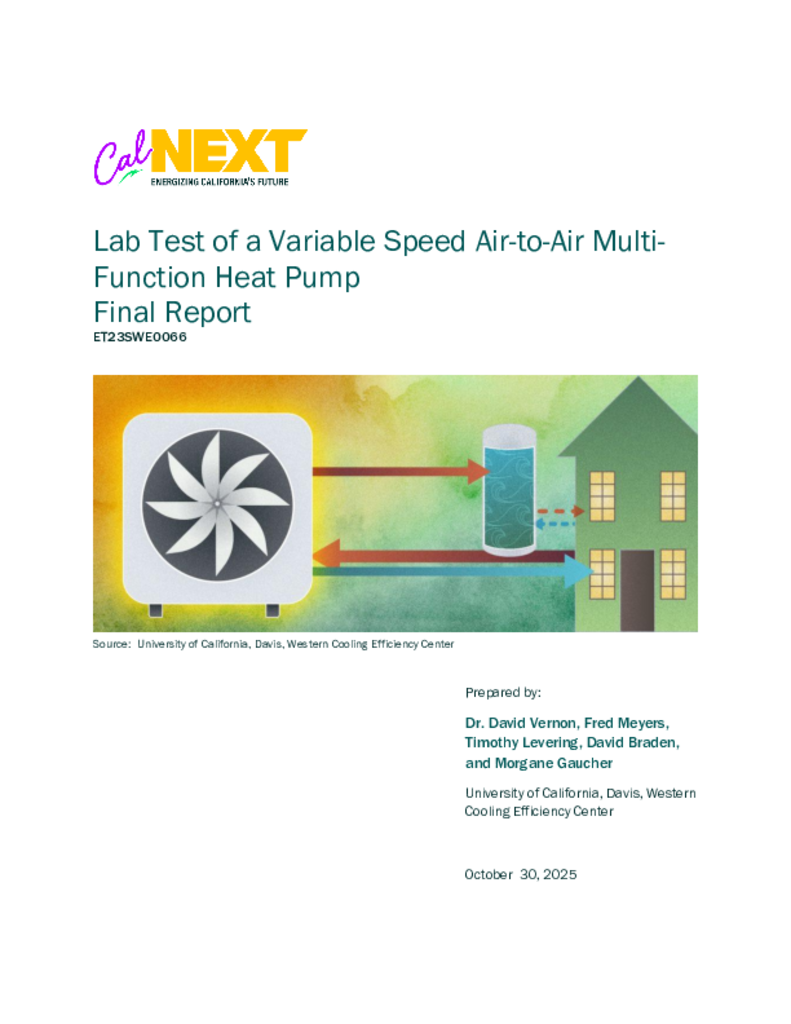ET23SWE0066 - Multifunction Heat Pump Lab Test – Variable Speed
Heat pump space conditioning and water heating can greatly reduce energy consumption compared to existing electric resistance or natural gas combustion options. Requirements for electrical service upgrades add cost and installation delays for customers considering retrofitting heat pumps for space conditioning and or hot water heating. 30% to more than 50% of all homes are expected to require electrical service panel upgrades to fully electrify.
Residential Multi-Function Heat Pumps (MFHP) use one efficient compressor and outdoor heat exchanger coil to provide space cooling, space heating, and domestic hot water heating. These systems offer many energy efficiency benefits. Air-to-air variable speed versions of these MFHP systems have the potential to eliminate the need for electric resistance backup heaters reducing the maximum power requirements so that full capacity systems can fit on existing electrical panels in many retrofits.
Field test results for single speed MFHP Villara AquaThermAire, that uses R-410A, show good energy efficiency performance for the typical space conditioning and water heating modes as well as the capability to use waste heat from space cooling to heat hot water during the summer.
Multiple HVAC manufacturers plan to offer variable speed MFHP products in California soon with the potential for even greater energy savings than single speed MFHP equipment. This project will test the efficiency and capacity performance of one variable speed air-to-air MFHP across a range of outdoor air conditions to match California climate zones for space heating, space cooling, water heating, and for simultaneous space cooling with heat recovery water heating. These lab test results will then be used to develop equipment performance curves for use with EnergyPlus and CBEC-Res to estimate energy savings in residential buildings.
A preceding ET project currently under way will complete laboratory testing of a single speed MFHP. This project will comapre the lab measured performance of the single speed and variable speed MFHP equipment.
Future measure development projects will use the Energy Plus performance curves developed int his project to estimate energy savings for variable speed MFHP equipment for custom and deemed programs. Future project can test air-to-air MFHPs from other manufacturers to evaluate the range of MFHP equipment performance, and future field demonstration projects will verify installation cost savings, energy savings, and customer satisfaction including sites in DAC and HTR customer buildings.
Residential Multi-Function Heat Pumps (MFHP) use one efficient compressor to provide space cooling, space heating, and domestic hot water heating. Variable-speed air-to-air MFHPs can have lower peak power consumption compared to the typical two separate heat pumps, for space conditioning and water heating. This means variable-speed MFHP may enable retrofit electrification without electrical service panel upgrades reducing cost and installation time. This project laboratory tested a 24kBtu/h (7.1kW) rated variable-speed air-to-air MFHP, measuring capacity and energy consumption in all operating modes across a range of outdoor conditions that match California climate zones.
At 95℉ outdoor and 80℉ indoor temperatures, the space cooling capacity at full rated compressor speed was 24.8 kBtu/h (7.28 kW) with COP of 3.42, and at intermediate speed was 15.7 kBtu/h (4.60 kW) with COP of 4.32. At 47℉ outdoor and 70℉ indoor return air temperatures, the space heating capacity at full speed was 24.8 kBtu/h (7.28kW) with COP of 3.96, and at intermediate speed was 13.2 kBtu/h (3.83 kW) at a COP of 4.90. At 47°F outdoor, the unit heated water from 65 to 120°F in 48 minutes and heated from 65 to 127°F with a capacity of 7.25kW and COP 3.24. The unit achieved an estimated first-hour rating of 86.4 gallons. Heat recovery from space cooling for heating hot water from 110 to 120°F saved an average of 33% of electrical energy compared to separate cycles. Heat recovery mode with 80°F indoor heated the water tank from 65 to 125°F with a combined space cooling and water heating COP of 7.9.
The measured results were analyzed to develop performance curves that future projects will use in simulation tools to estimate annual energy savings in multiple types of residential buildings across climate zones.

